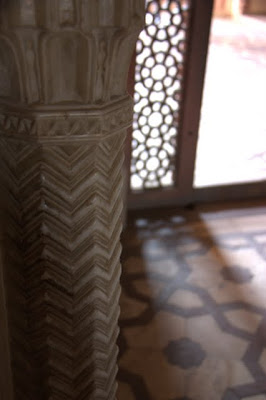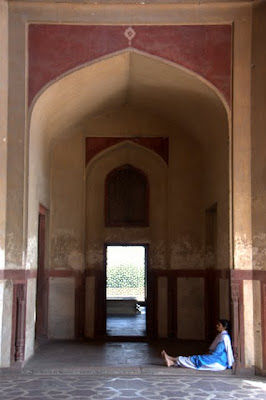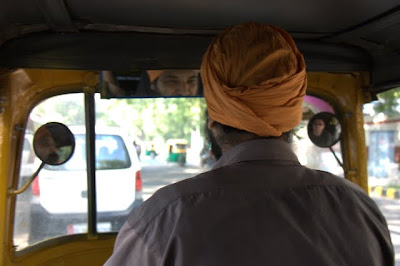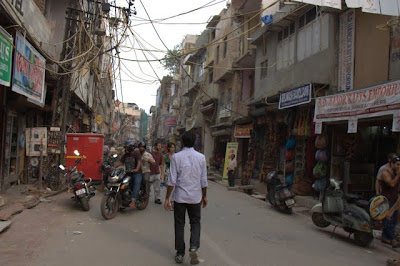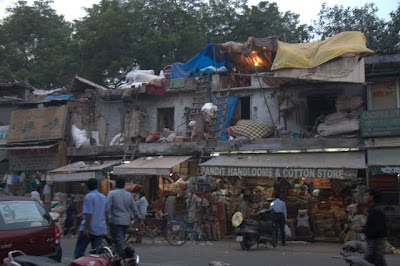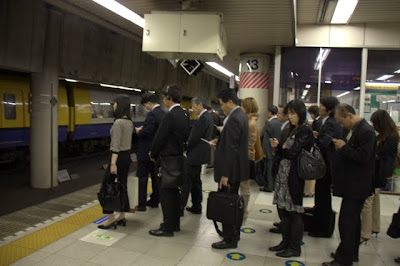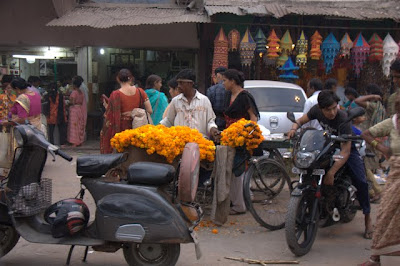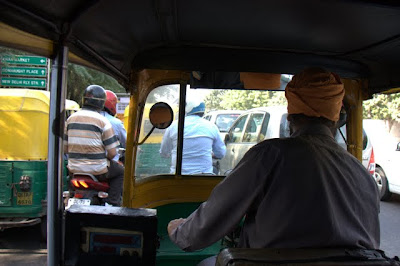Delhi and the Obamas
I think it is fairly obvious from our posts about India so far that Delhi, India’s capital, was our least favorite spot in India. Everything I wrote about India happens all at once in Delhi, all day long, with no respite. Unfortunately for us, it also was our first stop in India. In most of the places we visited in India, the highlights outweighed the lowlights, but we didn’t find much to love about Delhi. We spent most of our four days in Delhi on logistics, quickly realizing how long it takes to get anything done in this country. I swear we spent most of our time riding the metro back and forth from our hotel in East Patal Nagar. We thought it might be a good idea to stay in a non-touristy area in New Delhi, but our plan backfired. The neighborhood where we stayed wasn’t any less hectic, we had trouble finding places to eat, and we constantly had to ride the crowded metro to go anywhere.
We did find a little time to take in Delhi’s craziness and some of its sights, including Humayun’s Tomb, which would be visited by President and First Lady Obama several weeks after us during their trip to India. The Obamas’ every move was broadcast on Indian news stations, although we suspect it was probably nothing more than a blurb at home. Anytime we replied the United States in response to inquiries about where we were from, we’d receive a hearty response of yes, Obama! Coming to India! But much like at home, at least according to an Indian news magazine I picked up after the Obamas left, Michelle was a bigger hit than her husband during their visit. She impressed the Indians by dancing freely with children during a school visit, but also like at home, she still can’t catch a break for her outfits. The Indians thought her outfit choices were drab and would have liked to have seen her in brightly colored saris. Hey, at least she covered her pipes.
New Country Day
One of my favorite things about traveling non-stop for an entire year is what we call New Country Day. Even though New Country Days usually involve long uncomfortable bus rides, or overnight trains, or multi-leg flights with time changes, and figuring out logistics like where to stay, how to get around, and where to eat, New Country Days have a level of excitement and anticipation unmatched by any other day. On New Country Day, the whole country lies before you, waiting for exploration.
As much as I enjoy seeing the subtle ways that the cultures of neighboring countries blend into each other when we travel overland, one unique aspect of flying is how it drops you right into a completely different environment. By this point in our trip, we’ve had some pretty big transitions: France to Morocco, Spain to the Czech Republic, Poland to Ireland, Ireland to South Africa, South Africa to Jordan, Jordan to South Korea. And, of course, Japan to India.
You probably couldn’t find two countries who are fundamentally different: Japanese society is predicated on order, and Indian society is predicated on anything but. One of the reasons I think I found India to be so shocking was because we just had spent a month in Japan. Japan was pleasant and enjoyable, but by the end, we were a little bored and itching to move on. And move on we did.
(A note about Delhi’s metro – the picture above doesn’t really reflect what it was like most of the time. I would have loved to have taken a picture in the height of the crowds, but it is a little hard to use your camera when you are being jostled and pushed in all directions. At times, the metro cars are stuffed to the gills, meaning that people have no room to stand and don’t fall down only because they are being held up by the compression of the crowd. When the metro rolls up to the platform, people impatiently waiting for the metro push their way on as people already on the metro push their way off. In the more crowded, popular stations, an attendant tries to keep people in line. Try being the operative word. As you can imagine, as unpleasant as it is for men to ride Delhi’s metro, it can be distressing for women. The first couple of times we rode the metro, I rode with Sean in the general cars, doing my best to shield myself from stares from the men around me with a scarf and sunglasses. Once we started encountering metros that were overflowing, I separated from Sean to ride in the women’s only car. Delhi instituted the women’s only car so women can avoid the physical contact, leering, and groping that can be part and parcel of riding in the general car. Yet I’m not sure that riding in the women’s car was much better. I may not have to stand pressed between sweaty men, but the leering was worse. Inevitably, the overstuffed nature of the men’s car compared to the extra room in the women’s car meant that men overflowed into the front of the women’s car. It often seemed like the most pervy men took advantage of overcrowding to get an unblocked access of a car full of women. Some defiantly strode right into the middle of the women’s car. It is not surprising, I suppose, that things are so bad that a women’s only car is required, that some men don’t follow the rules. At the most crowded stations, enforcers boarded the women’s only car and shouted at the men until they scurried away. Interestingly, all of the enforcers that I saw – the few that there were – were petite women. I didn’t realize until I wrote this post that the women’s only car had only been instituted in the month before our arrival, so perhaps conditions have improved.)
(As a further sidenote, Japan also has women’s only cars, but the restrictions only applied during rush hour. We never saw a need for a separate women’s car firsthand during our subway travels in Japan.)
Impressions of India by a Type-A Personality
India. More than any other place that we have been, and I expect, more than any other place that we will go, India can’t really be described, only experienced. Perhaps that is why I am having so much trouble, now, articulating what India was like. Removed our Indian travels, I feel like I’m being melodramatic when I try to put into words the feelings and emotions I felt while we were there. But I know what I felt, particularly in those early days.
Right off the bat, India was intense, setting off a roller coaster of emotions that never subsided, only lessened as we grew more used to our crazy surroundings and as we traveled south, where India tends to be calmer. In India, I felt shock. I felt crowded. I felt alive, but very aware of my own mortality. I felt amazement. I felt sadness. I felt frustration. I felt disgust. I felt awe. Above all else, I didn’t feel bored. There’s too many layers to India’s chaos to feel bored.
Peeling Back the Layers
For starters, finding clean places to eat and drink, especially on a budget, wasn’t always easy. This was a problem more so in the north than in the south. Most of the cheapie rooms were rather dingy, and most of the time mid-range wouldn’t get you more than the addition of toilet paper. Needless to say, we put our sleep-sacks and travel towels to good use that month. Sometimes, for lack of a better alternative, we’d eat in crowded guidebook recommended restaurants that we’d probably report straight to the health department at home. We wouldn’t even want to touch the grimy menus, let alone eat the food. We ate and slept with swarms of ants in close proximity. Yet the ants were the least of our problems. As long as they wouldn’t actually be on our food – like they were one time when I was eating a candy bar and ants started crawling up my arm – or on us or our stuff – like they were another time when the infestation in our bathroom found their way into our bags – they were just something else I had to force myself to ignore. The cockroaches we’d see scurrying down the street, or most horrifyingly in the bathroom of a boat we rented in Kerala, I refused to get used to.
We’ve seen litter and garbage in other countries, but not like India. We started showering at night to rid ourselves of the day’s grime. In Delhi, in particular, the air was so thick with smog and pollution that it felt as if we were breathing whole particles, and in fact we were. I’d blow my nose and the tissue would be black, much like when Sean’s would be when he was demolishing 110-year-old smooty plaster in our old house. Only all I did was walk down a street. I bought a scarf whose most useful function was covering my nose and mouth as we zipped through exhaust clouds in rickshaws. My eyes were so irritated that I couldn’t wear my contacts for a week.
Venturing Outside
Being outside for any appreciable length of time wore your nerves down. Walking down the road is like navigating an obstacle course. One has to avoid things like protruding slabs of concrete, if a sidewalk exists at all; puddles of standing water; piles of trash; fires; dog shit; cow shit; people walking; people sleeping; people urinating; sidewalk vendors; down wires; piles of rubble; emancipated cows; and mangy, stray dogs. Horns are a constant sound in an overcrowded nation with little patience. Indian drivers use them as a you-better-get-the-hell-out-of-my-way-because-here-I-come warning and it seems they are continually coming. I got so fed up with the sound of horns that it drove me to seriously consider offering more to a rickshaw driver if he could manage to transport us from point A to B without use of his horn.
Every time we got in a taxi or rickshaw (basically a glorified go-cart) I feared for our lives. It is almost as if everything is operating on imaginary rails. I had no other way to explain how there are not more accidents in India, or how the chaos just functions the way that it does. We’ve seen countries where the lanes are just suggestions before, but India takes it to a whole new level. Rickshaws, taxis, cars, trucks, buses, cows, and pedestrians, all jockeying for a spot in the road at the same time, all sliding past each other with inches to spare.
1.3 Billion People
People often say India is “teeming with humanity.” I’m not sure what that means, but if it means that there are a lot of people everywhere, then it is a proper description. Not only are there a lot of people everywhere, there are a lot of people living their lives in public. Eating in public. Sleeping in public. Bathing in public. Laundering in public. Urinating in public. Hell, even dying in public. All of which is a bit overwhelming to people, like us, from countries where privacy is a zealously guarded right, where people live much of their lives behind closed doors.
Personal space simply doesn’t exist in India. The country is filled to capacity and then some. People overflow out of trains, subways, buses, cars, rickshaws, motorbikes. Signs admonishing people to stand in a queue are ignored. To protect your territory while you wait, pushing and shoving is required. Just when you thought you’d made it to a counter, still people cut in from the side. One day I got so fed up, I heard myself saying, Excuse me, sir, but I was next in line. I don’t know why. I knew it was futile. We have to adapt to their customs and norms. They don’t have to adapt to ours.
Not only do you not have any actual personal space in public, you also don’t have any mental personal space. Between the honking, the traffic, and the crowds, there’s not a lot of room to think. There’s always people, so many people. And a lot of them want something from you. There has been begging in every single country we have visited, but nothing like India. A man with his legs permanently disfigured into a cross-legged position, crawling around on his hands, thumping on your table for your attention. A woman with a child, both with tears streaming down their faces, tapping the window of your cab, pleading with you, over and over, to spare her some change. Then there’s the touts and the scammers, with schemes so elaborate that I couldn’t always even figure out exactly how they were trying to get us to part with our money. We actually found the touts to be more aggressive in Morocco, but damned if they are not persistent in India. Rickshaw drivers would follow us down the block, long after we said no. Conversations that started off so innocently – where are you from? – usually led to no good. Even those people who weren’t trying to take advantage of us often gave us misinformation, not because they were trying to mislead us, but because they don’t want to admit they don’t know.
The worst way that India got into your head was the staring. It didn’t happen everywhere – the non-touristy areas were usually worse – but when it happened, there was no ignoring it. When metros rolled up in Delhi, stuffed to the gills with men, except for the last car, which was slightly less stuffed with women, everyone’s eyes turned to us. When we’d walk down the street in certain areas, we’d pass a group of men, and I’d feel their eyes bore down on me, and if I dared turn around when they had passed, I would see at least one of them, looking over his shoulder. When I’d use our computer in an airport, or on a ferry, a little boy would stand right next to me, watching every word that I typed. When we and a newfound Irish friend waited for a train in a small-town railway station, every single person in the station watched our every move, even going so far as to completely turn around and hang over the back of their seats to get a better view. Meanwhile, a pig strolled through the station, and no one – except us of course – gave the pig so much as a glance.
Down the Rabbit Hole
And that’s India for you – there’s madness all around, but no one notices but you. Not Indians, not even most of the other travelers around. This is what starts to play head games with you. I had trouble picturing any of our Indian friends, who seemed so mild-mannered and calm, here in the middle of the chaos. Sean kept reminding me that for the Indians at least, this was their norm. This is where they grew up, so nothing is out of the ordinary.
That’s what I could never get past. We met a really nice guy on the train from Delhi to Agra, one of the few middle-class Indians with whom we had an opportunity to interact. He was going home for Diwali. It was our first Indian train ride. He told us he lived in the United States for a while, but returned to India. We asked him why. He replied, its boring in the United States! During the train ride, he pulled out his laptop, with his countrywide 3G data plan. He showed us the website of the company he worked for, a sort of Indian Yelp, which reviewed restaurants in the big cities. As he sat, talking about good Italian places in Mumbai, I was only half-listening. I kept staring out the window, at the garbage, at the men urinating on the tracks, at the shacks lining the tracks, at the scrawny women working in the fields, at the people jumping on the trains as they rumbled by. To him, it was as if none of these things existed.
India made me feel like Alice, like I tumbled down a big, long rabbit hole. The only thing that was out of the ordinary in India was me. Everyone and everything else fit together, its own functional dysfunction. I’d be the first to admit that I’m too uptight for India. India made me anxious. The only thing you can expect is the unexpected, and you always need to stay on your toes. I’d feel exhilarated one moment, only to come crashing down the next.
I can see why India harbors people of so many faiths. It takes devout spirituality, belief in higher powers, suspension of disbelief. India is no place for realists or cynics. The gems are definitely there, but you have to dig for them.
All of this makes it sound like I hated India. While I may have said that a time or two while we were there, I didn’t really mean it. While I was there, I let frustration overwhelm me. Removed from India’s chaos, I can appreciate the time I spent there, the good and bad. We saw hauntingly beautiful things, met kind people, ate fantastic food, and learned a lot about this country, which is only going to increase in prevalence on the world scene in the years to come. More than anything else, I can’t recall another time in my life when I was filled so full with constant fascination.


